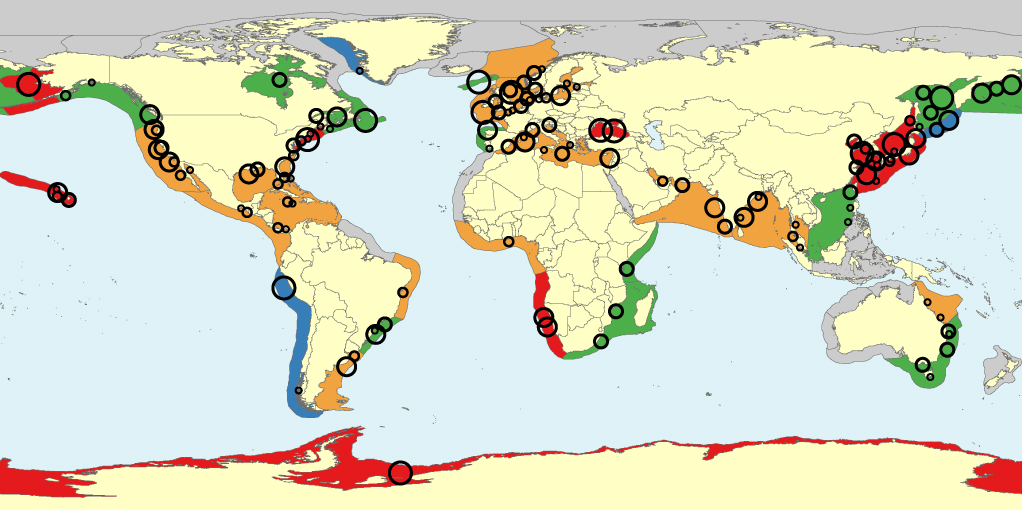The Great Migration Slowdown

Move volume (the number of individuals that moved in 2024) decreased 8% compared to 2023, marking a significant shift in American mobility patterns. The total number of Americans who moved in 2023 was 25.6 million, which was still a whopping 9% fewer than the total number of people who moved in 2022. This represents the lowest percentage of Americans moving since records began in 1948, with the 25.6 million Americans who moved in 2023 constituting 7.8% of the population, which is the lowest percentage of relocaters ever recorded.
The reasons behind this dramatic decline are complex but telling. People were priced out of relocation at every turn, as home affordability hit a historic low last August while at the same time, mortgage interest rates jumped to their highest levels since 2022. It’s like trying to change lanes on a highway where all the exits are blocked—Americans simply can’t afford to make the moves they once did.
The South’s Magnetic Pull Continues

Southern states remained primary draws for those moving, with top destinations including South Carolina, North Carolina, Tennessee, Texas and Georgia. The numbers are staggering: With a population gain of nearly 1.8 million — a change of 1.4% between 2023 and 2024 — the South added more people than all other regions combined, making it both the fastest-growing and largest-gaining region in the country.
What’s driving this southern stampede? The South was the only region with positive net domestic migration, where the number of people entering the region exceeded those leaving. Within the South, Texas (562,941) and Florida (467,347) had the largest numeric gains, and the District of Columbia grew the fastest (2.2%) from 2023 to 2024.
California’s Historic Exodus

For the first time in a decade, California has overtaken Illinois as the top state people are fleeing. California outranked Illinois as the top outbound state for the first time in 10 years. The Golden State is hemorrhaging residents at an alarming rate, with California experiencing the largest net domestic migration losses between 2023 and 2024 at -239,575.
The financial pressure is real and measurable. A survey conducted by Emerson College Polling in October 2024 found that 56% of Californians have considered leaving the state for financial reasons. More than half (54%) of those who left had incomes of $150,000 or more, indicating that even high earners are struggling with the state’s cost of living.
The Tax Factor Nobody Talks About

Americans were on the move in 2024, and many chose low-tax states over high-tax ones, with the latest commercial moving data finding that Americans are moving to low-tax states from high-tax states. This isn’t just correlation—it’s causation. Of the 26 states whose overall state and local tax burdens per capita were below the national average in 2022, 18 experienced net inbound interstate migration in FY 2024, while of the 25 states and DC with tax burdens per capita at or above the national average, 17 of those jurisdictions experienced net outbound domestic migration.
The pattern is crystal clear: States like California, New Jersey, New York, Illinois, and Massachusetts are among the biggest losers, while states like South Carolina, North Carolina, Arizona, Idaho, Florida, Indiana, and Tennessee are among the biggest winners. Your wallet speaks louder than your political preferences when it comes to choosing where to live.
Remote Work’s Lasting Impact

The pandemic didn’t just change where we work—it fundamentally altered where we choose to live. The prevalence of remote work shot up from less than 6% of the population in 2019 to at least triple that in 2021. While remote work has stabilized, WFH levels have remained flat in 2023 and likely 2024, with the return to the office movement dying at the end of 2022 and WFH levels stabilizing at about 30 percent of days.
This shift has had profound effects on housing markets. From November 2019 to November 2021, the surge in remote work alone increased home prices by approximately 15 percent. Home prices rose especially rapidly in more rural areas, in smaller markets and in lower density counties of large metro areas. Remote workers are essentially gentrifying small towns with their big-city salaries.
The Illinois Immigration Exception

Illinois presents a fascinating case study in how international migration can mask domestic flight. A massive influx of 112,955 international migrants boosted Illinois population in 2024, despite the state losing 56,235 residents to other states, ranking third nationally behind California and New York. International migration added 112,955 new residents – 10 times more than what the state received in 2021 and nearly five times what the state gained on average from 2010-2020.
This influx isn’t organic growth—it’s largely the result of political decisions. Illinois may have Texas Gov. Greg Abbott to thank: He shipped migrants by bus and plane to Chicago and other sanctuary cities to relieve the border crisis. Without this artificial boost, Illinois would be in far worse demographic shape.
The Retirement Migration Boom

One of the most surprising migration trends is the massive increase in retirement-related moves. According to the latest U.S. Census Data, by far the reason for moving with the biggest year-over-year growth was retirement, with about 44% more Americans moving to retire in 2023, compared to the year before. This isn’t just about moving to Florida anymore—many retirees reported moving closer to — or with — their families, with 9% of people in the so-called “sandwich generation” reporting that parents aged 65 years or older moved in with them sometime during 2023.
The economics of retirement migration are compelling. With remote work normalizing flexible living arrangements, retirees are following their adult children to more affordable areas rather than traditional retirement destinations. This creates a double migration effect—working-age adults flee high-cost areas, and their parents follow.
Small Cities Are the New Winners

Top inbound cities include midsize metropolitan areas, including Charlotte, NC, Dallas, TX, Greenville, SC, Nashville, TN, and Raleigh, NC. These aren’t the megacities that dominated previous decades—they’re the Goldilocks cities that offer just the right balance of opportunity and affordability. Americans are looking to move to great-value small cities in the South and Mountain West, but they’re also exploring more possibilities nationwide than in recent years.
The pattern is clear: Rather than flocking en masse to a handful of “it” destinations, Americans are instead branching out across a wider range of cities and states, driven by personal priorities like affordability, quality of life, and remote work flexibility. We’re witnessing the death of the superstar city phenomenon and the rise of the “good enough” city.
The Lock-In Effect

Many Americans who might otherwise move are trapped by their own good fortune. The lowest number of outbound states in over five years indicates many people may not be moving at all, likely an impact of the “lock-in effect” that disincentivizes homeowners to move and drives housing prices up. If you locked in a 3% mortgage rate in 2020, the prospect of trading it for a 7% rate in 2024 is enough to make anyone stay put.
Mortgage rates and house prices remained high in 2024 and didn’t come down from the 2023 numbers, so instead of waiting for the prices to decrease, many Americans decided where to move based on the current mortgage rates and housing trends. This creates a bizarre housing market where the people who most need to move can’t afford to, while those who can afford to move often choose not to.
International Migration as Population Lifeline

While domestic migration tells one story, international migration is writing another. The U.S. population grew by nearly 1.0% between 2023 and 2024, with an annual growth rate of 1.0% being higher than what we’ve seen over recent years. This growth is almost entirely due to international migration: With a net increase of 2.8 million people, international migration accounted for 84% of the nation’s 3.3 million increase in population between 2023 and 2024.
The demographic implications are staggering. The U.S. foreign-born population reached a record 47.8 million in 2023, an increase of 1.6 million from the previous year, marking the largest annual increase in more than 20 years. Without international migration, many states would be facing population decline and economic stagnation.
The Future of American Movement

Looking ahead, the trends suggest we’re entering a new era of American mobility. The era of blockbuster migration hotspots may be behind us, with a more multifaceted landscape emerging where diverse regions across the country find room to grow in 2025. The third phase is likely to start in around 2025 when WFH levels will start to slowly rise again, driven by ever improving technologies.
The implications extend far beyond housing markets. The adoption of flexible work arrangements is likely to keep evolving from 2024, further influencing housing demand and real estate values, necessitating a close watch on how remote work will continue to redefine migration patterns and reshape housing markets in the coming years. We’re not just changing where we live—we’re redefining what it means to be rooted in America.
Conclusion

The great American migration story of 2024-2025 isn’t just about people moving from point A to point B—it’s about the fundamental restructuring of American society. Tax policy, housing costs, remote work flexibility, and international migration are creating winners and losers in ways that will echo for generations. The South’s rise isn’t just a trend—it’s a tectonic shift that’s redistributing political power, economic opportunity, and cultural influence across the American landscape.
As we watch these patterns unfold, one thing becomes clear: the America of 2030 will look dramatically different from the America of 2020. The question isn’t whether these changes will continue—it’s whether our institutions and policies can adapt fast enough to manage them. What would you have guessed about where your neighbors might be living five years from now?



